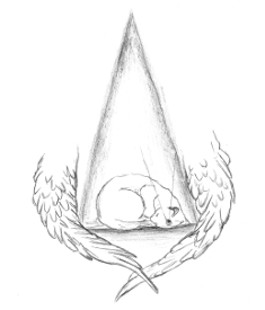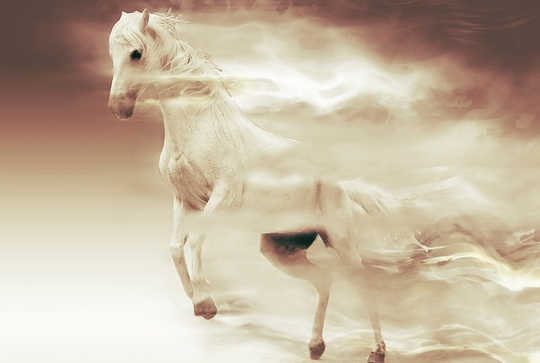
Image by ArtTower
To domesticate an animal means to bring them into alignment with our human desires and perspectives, which are usually very different to those of an animal. Animals in the wild live solely on instinct; without that instinct, they would be someone else’s supper.
Domestication also means not being completely free to roam or to even eat as they please. Pets therefore align with their humans for only one of two reasons: either by their own choice or from a place of surrender. When they do, they have a powerful impact on our lives.
Nature,including the animal world, demonstrates to the human species just what balance, alignment, and non-resistance look like. All being well, your animal has no expectations of you. Think back to when you’ve entered a room while your animal is relaxed and lying down.
Unless you are holding food or a leash in your hand (let’s get real here!), they usually stay where they are and simply watch you from the corner of their eyes, reflecting acceptance and unconditional love. These qualities of acceptance and love make us feel good as they are such powerful and high vibrations. Whenever we feel them, we come more into alignment with our higher selves, with each other, and with a higher divine source.
Get The Latest By Email
We actively decide to communicate with animals for a variety of reasons. It could be pure curiosity, or wanting to understand them better, or perhaps we have specific questions we want to ask, or we simply want to tell them just how much we love them—although they already know this, having always felt that love.
I have always joked that working as an animal communicator is sometimes like watching a movie. At times it feels like all I need is a box of popcorn and a slushie to complete the picture. I’ve often wished that other people could plug into what I am seeing, as it’s sometimes frustrating that I cannot adequately describe it. Regardless, there are often tears of happiness and tears of sadness, and plenty of laughter in between from all three of us, the horse, the owner, and myself.
CASE STUDY: Brighty – Saying Goodbye
I have known Charlene for many years. Her cat Brighty had just turned 21 years old, and although 21 is a remarkable age for a cat, her health was suffering. She had always been rather thin, but now she was struggling to eat properly.
She was still feisty, and her eyes showed that she was full of life, but her body just could not keep up. Charlene knew it was time to say goodbye to her beloved companion of the last 21 years, and she made the necessary arrangements to have her put down.
As I was on the road that day, I only managed to connect with Brighty an hour before the appointment with the vet. It was like she was on a stage and there was a spotlight shining down on her. The edges of the light had little specks of gold floating around and her crown chakra was activated with light streaming out. She was ready to ascend and help was at hand in the form of a loving angelic presence. I sent the image through to Charlene with a parting message from Brighty. This image really helped Charlene with the process of finally saying goodbye to her beloved cat. I hope it brings comfort to anyone who is or has been in a similar situation.
CASE STUDY: Tolero – A True Leader
One of the things I love about my job is that I never seem to stop learning about animals. Although there is sometimes a recurring theme among animals who live together, each session is totally and utterly different. Something that always stands out for me, though, is that an animal’s personality and outlook on life teach everyone around them and enrich their lives, too. I will forever be grateful for the knowledge they have so readily shared with me. You cannot get that kind of wisdom and understanding from Google, that’s for sure!
One such remarkable session was with Tolero, a beautiful gelding. He is stabled in Tokai Forest, Cape Town, with a herd of about 15 other horses. In fact, he was the third horse I had worked with in the herd. He is a fine fellow, with a gentle presence, and throughout the entire session he stood placidly. At times, he even nodded off, and I played with his bottom lip, teasing him to wake him up to continue our interaction. Energetically, he came across as a calm and loving horse, a dream to work with.
He is of medium build, slightly bigger than a pony, and only nine years old. Because of this and his gentle and loving nature, it came as a surprise to me when his owner mentioned that he was head of the herd. This was the first time I had ever connected with a herd leader, and I had absolutely no knowledge of how they usually behave or interact.
Apparently he is not aggressive in any way; he simply leads with a look or by using his body language, such as putting his ears back. In my humanness, I had assumed that a leader is always dominant and assertive, a typical extrovert. I had also imagined that a herd leader would have to be quite impressive in height, build, and looks—something more like a stallion. When I found out about Tolero, though, I was forced to put all my preconceived ideas aside and simply listen to him.
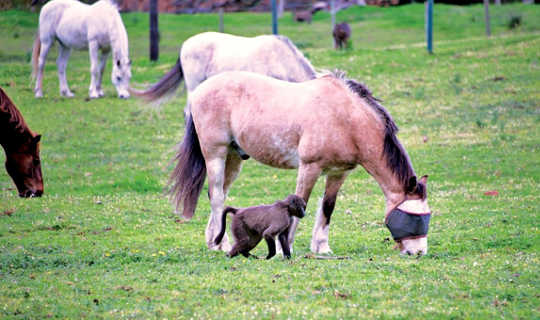
Tolero and Company
Because animal communication is telepathic, a reading is often a three-way conversation between me, the animal, and the owner. Tolero teased me for being surprised and scoffed at my blatant ignorance of how things in the animal kingdom were often different. I just laughed and agreed with him wholeheartedly. He led with firmness and love, and he didn’t have to do or say much to let everyone around him know exactly how he felt. Frankly, it’s a pity more of our human leaders are not like this horse.
Tolero mentioned that there was a particular horse in the herd he was worried about. It was a younger gray who had recently seemed to withdraw from the rest of the herd. He was keeping to himself, and this worried Tolero, as he thought he might be depressed. He mentioned that he had posted two sentries to keep an eye on him and help him through this downward turn. I was totally blown away by his concern and how he managed it.
Lastly, Tolero also felt he had to mention an incident he was not particularly happy about. He asked his owner to please not throw her cabbage leaves on top of the compost pile. Apparently, one of the horses in the herd had managed to get to them and chomped his way through a feast of cabbage leaves. A few hours later, his explosive farts had sent the rest of the herd gasping for fresh air and scattering to avoid standing downwind from him. Would she please be so kind as to work her cabbage leaves into the pile of compost in future, to prevent this kind of thing from happening again?
CASE STUDY: Bob – The Lover of Home-Cooked Food
Dogs love food. It’s incredibly important to them, and they reall ylove sharing this part of their lives with me. They like sharing their owner’s food, and they tell me all about the food they are getting. What they like and don’t like always comes up in a reading.
Bob is a lively (and spoiled!) terrier who simply adores his owner. In session, he had just one complaint about her: she didn’t cook enough! He loves the smell of cooking, but instead, they often get takeout meals.After a goodl augh, his owner agreed with him. She doesn’t enjoy cooking, and as it’s only her and her husband, they often get ready-made meals (Bob’s interpretation of takeout) delivered to them. Sorry, Bob… we do understand!
CASE STUDY: Patch – The Stage Director
Not all readings are serious; some are very funny and stick in your mind for a long time. When an animal has a great sense of humor, it often comes through in a session. One such case was a horse called Patch, a beautiful white and black spotted (as per his name) 12-year-old gelding. He has a soft and loving temperament, and he particularly adores women, whether in human or horse form. For him,there is nothing in this world more beautiful than a mare whom he can lovingly gaze at; it makes his world complete.
During as ession with him, I scanned his feet. Usually horses either praise their farrier or they openly dislike them.The best farriers have a loving and calm temperament. They take their time with the horse’s hooves and speak gently but firmly to them while filing and shoeing is underway.
If a horse has sensitive feet, though, or has perhaps had a bad experience with a farrier, there is a very good chance that they will play up when being shoed, hating the whole experience, refusing to stand still, and generally making things difficult.
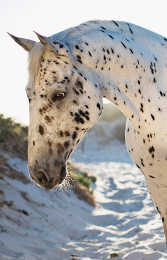 Patch
Patch
Patch fell in to the latter category. As soon as I reached his knee area, he told me he really did not like the way the current farrier had done his shoes. Ideally, the farrier should use a shoe that is closest to the horse’s size, but often this doesn’t happen. If they don’t have the necessary fit with them, they tend to make do and use the next “best” fitting shoe. Patch said it felt like the farrier had tried to file his front feet to fit the shoes, not the other way around (the way he conveyed this to me had me stumbling around the paddock on tiptoes,trying to describe to the owner what he was showing me).
The farrier had cut the sides of the hoof too short, then “boxed in” the remaining hoof and filed it to fit the shoe. This was only the case with the front two hooves. It felt to me like I was walking in high heels. I had hard hiking boots on that day and haven’t worn high heels in years, so my balance was totally off. I felt like a real idiot, especially with Patch laughing at my efforts.
He was determined to get the message across, though, and I had to act out and describe why the shoes didn’t work and how they made my feet feel. The lengths I sometimes go to, to convey a message!
At first, the owner looked at me as if I were mad, then started laughing as it finally all made sense to her, and in the end, we all had a good laugh at how ridiculous I looked. She was then able to tell me that she had suspected something was up with his shoes, and had decided two months ago not to shoe him anymore. The cheeky horse hadn’t bothered to mention that the horrible shoes had already been taken off. He was too busy explaining the situation and then enjoying himself at my expense!
CASE STUDY: Hogan – I Am Not What I Appear to Be
I was doing a reading with Catherine and her dog Hogan. Hogan looks like a mix of Maltese poodle and a few other breeds. He has the typical overbite common to the Maltese breed and his bottom teeth therefore stick out. He walks with a bit of a swagger, as if to say “I am The Man,” although he’s a real softie, too.
His owner wanted to know if he knew what mix of breeds he was. So I asked, and his reply was “a bit of Maltese and some Labrador.” Now I have worked with a lot of mixed breeds before, and since Hogan only weighs about 12kg and looks completely different to a Labrador,I questioned his answer. I told him to be serious and give me the right breeds. He still insisted that he was part-Labrador.
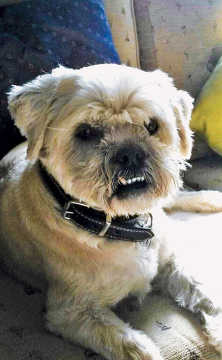 Hogan, “the Labrador”
Hogan, “the Labrador”
Our “silent” conversation continued for about five minutes, as I was sure there was no way he was a Labrador. I thought he was trying to make fun of me in front of his owner, which sometimes does happen, and I didn’t want his sense of humor to be at my expense (this is often the case). After a while I relented, as he was so insistent. I explained to Catherine that I was just the messenger and gave her his answer. She started laughing, making me think, ”Here we go again!” When she managed to control herself,though,she confirmed it, and Hogan gave me a “see, I told you so” look. I was stumped.
She then went on to explain that a few years previously, Hogan had contracted biliary, also known as tick bite fever, and he had to have a blood transfusion to save his life. Just like humans, dogs are needed as blood donors, often to save lives in cases like biliary, surgical procedures, trauma, and accidents. Donor dogs usually go on to a donor roll, and the owner is contacted when the need arises. The donor that gave Hogan blood for his transfusion had been a Labrador. So he had been 100 percent correct in saying that he was part-Labrador, which he thought was the best thing ever. Note to self: Stop thinking and analyzing; just pass the message on!
CASE STUDY: Justice – The Disappearing Act
Justice was a gorgeous ginger cat who lived in a lovely complex in Durban with Pam and Chris. Chris had cancer and had recently undergone surgery. He was bedridden and slightly depressed, and he took great comfort in Justice lying with him on the bed. Justice would stay with him for a day or two, but then disappear for anything from one to several days. During this time Chris would miss him terribly and it was up to Pam to go out and try to find him.
The complex they lived in was huge, with over 100 units in total, so it really was a major mission to walk around, calling for a missing cat. Pam asked me if I could try to find out where Justice disappeared to, so it would be easier for her to fetch him and bring him back to console Chris. I did the reading at a distance, and Justice knew exactly what was going on in his home. He knew that Chris had cancer and also had a sixth sense that he would soon be losing him. So sometimes it all became a bit much for him, and he took himself off for a break. I asked him where he went, and he said there was no cause for alarm. He mentioned a unit number in the complex, where he went to “recharge.”
 Justice
Justice
When Pam received my email with this information, Justice had once again done a disappearing act for a few days and Chris was asking for him. She was not quite believing what she had read but desperate to find him, she grabbed her cat basket and set off.
It was a good walk, 1 km away, and when she eventually arrived at the unit he had mentioned, she stood outside calling his name. Nothing happened at first, then just as she was about to give up, who should come waltzing through the garden with not a care in the world but Justice! More astonished than annoyed she scooped him into the basket and took him back home to reassure Chris.
This pattern of Justice disappearing and Pam going to fetch him continued for several months until Chris was moved to a hospice and finally passed away. The disappearing act was simply a cat trying to deal with the fact that his owner and friend would soon be passing on. Afterwards, he still occasionally disappeared, but Pam always knew where to find him.
CASE STUDY: Boland – Pink not White, Please
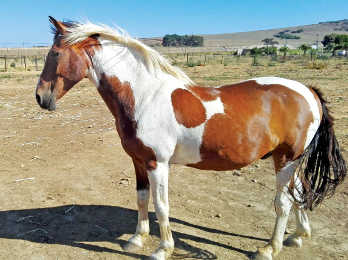 Boland
Boland
Boland is a gorgeous Boerperd who turned out to be a big softie at heart. During the session, the stable manager asked him what they could do for him or if there was anything that he specifically wanted. “Yes, please!” was the answer. “I want marshmallows, but only the pink ones. I don’t like the white ones.”
This was a strange request from a horse, as how would he even know about marshmallows? He is stabled at a riding school, though, and ridden by children, so my guess was that he had seen someone eating them and fancied one himself. I passed on the request.
A few weeks later, I was back at the yard working with another horse and was happily informed that one of the girls who rides him on a regular basis and absolutely adores him had bought him a packet of marshmallows. Not knowing his color preference, she offered him both pink and white ones after their session. Being a true gentleman, he accepted both colors from her.
After she had gone home, he moved away from the gate post and there, glowing in the Cape sun, were all the white marshmal- lows, lying in the sand. He had taken the white ones just to make her happy, but spat them out when she wasn’t looking.
©2019 by Diane Budd. All Rights Reserved.
Reprinted with permission of the publisher,
Findhorn Press, an imprint of Inner Traditions Intl.
All Rights Reserved. www.findhornpress.com.
Article Source
Energy Medicine for Animals: The Bioenergetics of Animal Healing
by Diane Budd Full of animal communication stories and ground-breaking research on animal energy fields, this book shows how, just as we humans are all here on this earthly plane to learn and grow, so are our animals. (Also available as a Kindle edition.)
Full of animal communication stories and ground-breaking research on animal energy fields, this book shows how, just as we humans are all here on this earthly plane to learn and grow, so are our animals. (Also available as a Kindle edition.)
For more info and/or to order this book, click here.
About the Author
 Diane Budd is a sought-after animal communicator and healer, serving to bridge the gap in understanding between animals and their human companions. She teaches workshops on animal communication, animal healing, and zoopharmacognosy and offers in-home consultations around Cape Town, South Africa. Author's Website: http://healinganimals.co.za/
Diane Budd is a sought-after animal communicator and healer, serving to bridge the gap in understanding between animals and their human companions. She teaches workshops on animal communication, animal healing, and zoopharmacognosy and offers in-home consultations around Cape Town, South Africa. Author's Website: http://healinganimals.co.za/


